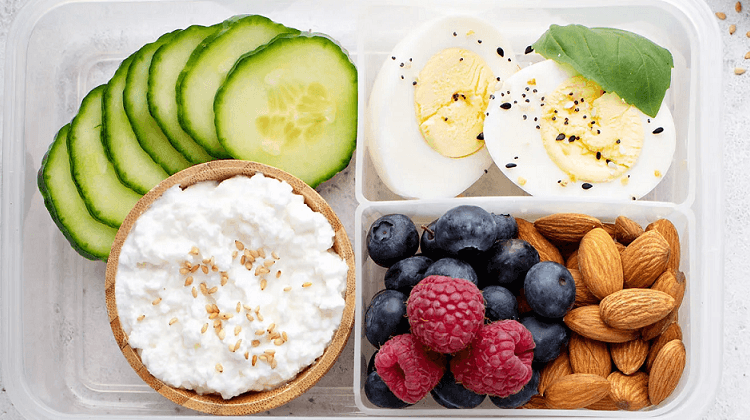Looking to bulk up? If you’re having trouble gaining muscle mass, just lift heavier weights and consume more food. However, for a shredded, strong physique, adding lean muscle mass should be your primary goal.
Every aspect of your efforts to get lean and bulk up your muscles — from the foods you eat to the length, frequency, and sorts of lean body workouts you perform — will all have an effect.
If you want to get jacked and shredded, you’re headed in the right direction, and these 5 fitness moves for a lean body that could last forever will help you get there in no time.
#1. Start Your Day With Breakfast
It’s important to make time for a nutritious breakfast every morning, no matter how hectic your daily routine may be. Breakfast consumption has been shown to increase metabolic rate throughout the day. It’s important to start the day off well by giving your body the vitamins and nutrients it needs, which means making sure your breakfast is full of healthy foods.
Breakfasts that are high in protein and fiber are superior to those that are high in refined carbohydrates because they help you feel full for longer and prevent blood sugar spikes. Eat something substantial, like a vegetarian omelet or granola with cinnamon and mixed nuts, instead of pastries and sugary cereals. The benefits of eating breakfast within an hour of waking are maximized, and the longer you go without food, the more likely you are to make poor food choices.
One study published in the medical journal Obesity found that after 12 weeks, women who ate a substantial breakfast (think fruit, bread and eggs rather than a quickie bar) lost more weight than those whose largest meal of the day was eaten at supper. The hunger hormones ghrelin and insulin were also lower in those who followed the diet.
According to the National Weight Control Registry, approximately 80% of people who have lost and kept off at least 30 pounds say that eating breakfast every day is one of the main reasons they were able to achieve and maintain their weight loss. In addition, morning eaters have been found to have lower blood pressure and cholesterol levels, as well as a reduced risk of cardiovascular disease and a shorter life expectancy.

#2. Have Timely Meals
Each of us requires a specific quantity of energy on a daily basis, and this energy must be distributed over the day in specific ways. Foods like starches, lipids, and proteins provide us with this fuel. Eating at regular intervals throughout the day provides the body with the fuel and nutrition it needs to perform at its best, helping us to get through everything on our to-do list. Ever hit the wall around 3 p.m. and needed a nap? This could be your body’s way of telling you that it needs food because you haven’t eaten in several hours (since lunch).
Meeting our energy and nutritional needs may be difficult if we do not eat enough throughout the day, as is the case if we only eat once or twice (e.g., protein, calcium, iron, fiber).You may find that when you don’t eat enough during the day, your body makes up for it by demanding food at odd times. If you skip breakfast, for instance, you can find yourself hungry in the afternoon and/or evening as your body attempts to make up for the lost energy. Or, if you don’t eat something around mid-afternoon, you may arrive for dinner feeling really hungry and end up eating too much.
Meal timing that is consistent with your body’s needs also aids digestion. If you go too long without eating, you may overeat at your next meal or eat too rapidly, both of which are bad for your digestion. If you chow all day long, though, you won’t trigger your migrating motor complex (MMC). Electromechanical waves of muscle contractions in the stomach help clear out any undigested food that has been sitting there for too long. But constant eating will prevent leftovers in the gut from being evacuated, which could subsequently lead to bloating.
Some research suggests that those who eat lunch later than 3 PM are less likely to experience weight loss success than those who consume their meal earlier. Another study indicated that people who limited their eating to the hours of 6 AM to 7 PM lost more weight than those who ate normally throughout the day.
Below is a sample meal schedule you can adopt for gaining a lean body and improving your overall health.
- 6am: Wake up
- 7-8am: Breakfast
- 10 to 10:30am: Morning Snack
- 12 to 1pm: Lunch
- 3 to 4pm: Afternoon Snack
- 7 to 8pm: Dinner
- 10pm: Bedtime
#3. Have Healthy Snacks When You Are Hungry
Although this is obviously sound advice, many of us don’t put it into practice. We don’t listen to our bodies, opting instead to eat when it’s “time to eat,” when we’re bored, or when we’re socializing with people who also happen to have food. These are examples of poor dietary habits.
Before everything else, don’t let yourself get too hungry because we’re not ready to eat or because we’re short on time. Have healthy snacks on hand at all times, whether at the office or while traveling, and eat whenever you feel even somewhat hungry. You’ll overeat if you wait until you’re starving.
You should also stop eating when you’re full. Due to our insatiable hunger, we frequently continue eating well past the point of fullness, resulting in a bloated and uncomfortable state of being. Maybe it’s the deliciousness of the food, or maybe we’re too preoccupied with conversation or a TV show to notice that we’re full after the first helping.
Eat more slowly, take a break from eating even if you don’t feel full, and pay attention to your body’s cues about when it’s time to stop. When you wait 5 minutes, you may realize that you are indeed full. If you want to slim down, you need to control your eating habits.

#4. Depend Less On Your Weighing Scale
Many people find success in losing weight by using a scale, but for others, the scale can be a source of frustration and discouragement. Regularly weighing yourself can help you maintain a healthy weight, even if you aren’t trying to lose any weight. However, the act of weighing oneself might be unpleasant at times.
You may have seen a little rise in your total weight, despite your best efforts to stay on schedule. Maybe you’ve been working out more frequently and harder than ever, but the scale still hasn’t budged.
As soon as you step on a scale, you are making a judgment about yourself that may affect your entire outlook on life. Many of us fight constantly with our self-perception, which is inextricably linked to the number we see on the scale.
You can find out your weight on a scale, but knowing your body composition is much more useful. Many of us put more stock in the number of pounds we’ve lost than in the percentage of fat we’ve lost, which is something the scale can’t tell us.
#5. Set Your Workout Plan
One of the healthiest decisions you can make is to formulate and implement target driven bodybuilding workout plans. Regular exercise has several health benefits, including lowering the danger of developing a chronic illness, enhancing balance and coordination, and aiding in weight loss. A regular exercise routine can also enhance one’s quality of sleep and sense of personal worth. However, the following should be taken into account when planning your exercise routine:
Think about why you want to get fit: Or is there something else driving you, like training for a triathlon? The ability to measure your progress and maintain your motivation depends on setting specific goals.
Set up a healthy routine: It is recommended that you engage in at least 150 minutes of moderate aerobic activity per week, or 75 minutes of vigorous aerobic activity, or a combination of the two. The instructions recommend breaking this task up into seven daily sessions. At least 300 minutes per week are advised for maximum health benefits and to aid in weight loss and maintenance. Still, any kind of physical activity is better than none. Health advantages can accrue from small bursts of activity spread out over the course of the day.
At least twice a week, you should engage in strength training that targets all of your major muscle groups. Try to complete just one set of each exercise with weight or resistance high enough that you reach muscular failure after 12 to 15 reps.
If you’re just getting started with a workout routine, take it easy at first. For assistance in developing a fitness program that can help you recover from an accident or manage a medical condition, see your doctor or an exercise therapist.
It can be difficult to fit in workout sessions, so incorporate physical activity into your regular schedule instead. Schedule your workouts like you would any other appointment. Whether you’re planning to take a stroll during your lunch break at the office, watch your favorite show while walking on the treadmill, or read while riding a stationary bike, it’s easy to fit exercise into your busy schedule.
Think of a variety of exercises to engage in: Cross-training consists of engaging in two or more different types of physical activity. Additionally, the risk of overusing or damaging a single muscle or joint is diminished when you cross-train with low-impact activities like biking or swimming. Walking, swimming, and strength training are just a few examples of exercises that target different muscle groups and can be done in rotation to keep things interesting. Use high-interval intensity training, which consists of short bursts of high-intensity activity followed by low-intensity recovery intervals.
It’s common for people to overdo it on their first few workouts, causing aching muscles and joints that lead them to quit exercising. Schedule breaks in between workouts to let your body relax and recuperate.
Write it down: When you put your goals into writing, it can help you stay focused and on track.

Be Patient With Your Results
In conclusion, patience is the most crucial – and challenging – component of any exercise strategy. Rather than constantly chasing perfection, aim to make changes that stick. You’ll see that there’s still opportunity for growth as you move closer to your goals and make progress. To gain lean muscle mass and improve your health, you should make exercise a priority in your life and make little adjustments to your diet as you go.


